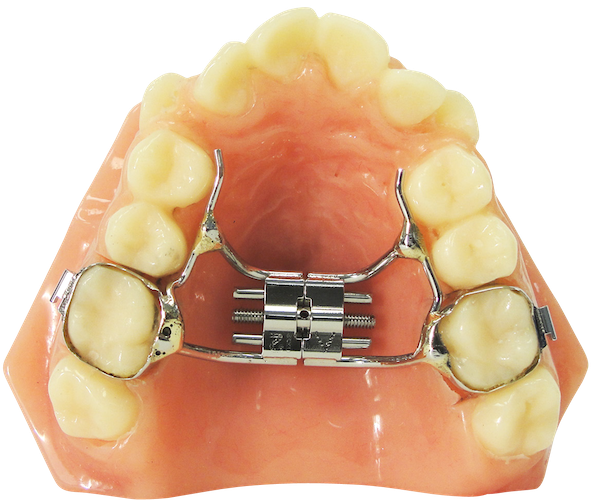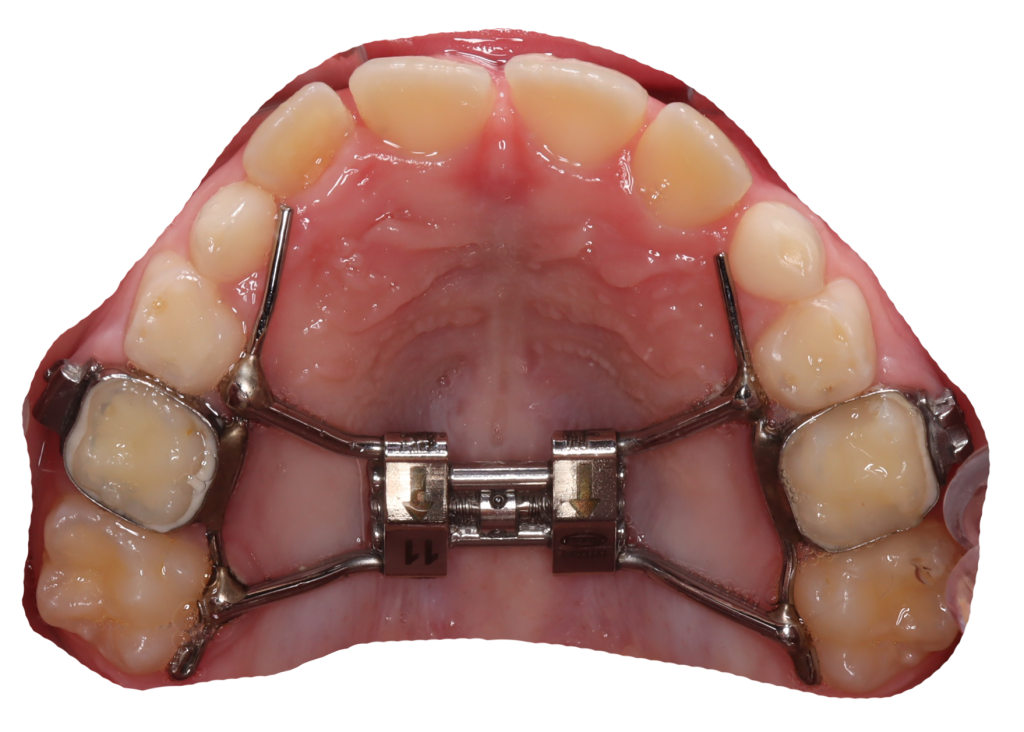https://upload.wikimedia.org/wikipedia/commons/c/ca/1×1.png
Orthodontics is a specialized field of dentistry that focuses on correcting misalignments and irregularities in the teeth and jaw. One common orthodontic treatment is the use of a Rapid Palatal Expander (RPE), which is a device used to widen the upper jaw.
An RPE is typically used in cases where the upper jaw is too narrow, causing crowding or crossbites. The device works by applying gentle pressure to the upper jaw, gradually widening it over a period of time.
During the initial consultation, an orthodontist will evaluate the patient’s dental and facial structure to determine if an RPE is necessary. If it is, the orthodontist will take impressions of the patient’s teeth and jaw to create a custom-made RPE.
Once the RPE is fitted, the patient will need to activate the device regularly, usually by turning a key or screw. This activates the expansion process, gradually widening the upper jaw. The patient may experience some discomfort during this time, but it is temporary and usually subsides within a few days.
Rapid Palatal Expansion (RPE) is a common orthodontic treatment used to correct certain dental and skeletal issues. It involves widening the upper jaw to create more space for the teeth and improve the overall alignment of the bite.
How does RPE work?

RPE works by applying gentle pressure to the upper jaw, specifically the palatal bones. This pressure gradually separates the bones, allowing for the expansion of the maxillary arch. The expansion is achieved with the help of a device called a palatal expander, which is custom-made for each patient.
The palatal expander is typically attached to the upper molars using bands or crowns. It consists of two halves that are connected in the middle by a screw. By turning the screw a small amount each day, the expander gradually widens, creating more space in the upper jaw.
Benefits of RPE in Orthodontics

RPE offers several benefits in orthodontic treatment. Firstly, it helps to correct a narrow upper jaw, allowing for proper alignment of the teeth and improving the bite. This can lead to improved chewing and speech function.
Additionally, RPE can help to create more space in the upper jaw, which can be beneficial for patients with crowded teeth. By expanding the arch, RPE can often eliminate the need for tooth extractions, which may be required in cases of severe crowding.
Furthermore, RPE can also help to correct crossbites, where the upper teeth bite inside the lower teeth. By expanding the upper jaw, RPE can help to align the upper and lower teeth properly, improving both the esthetics and function of the bite.
Considerations when using RPE
While RPE is a highly effective treatment, there are some considerations to keep in mind. The treatment is most effective when performed during childhood or early adolescence when the bones are still growing and more pliable.
What is RPE?

Rapid Palatal Expansion (RPE) is a common orthodontic treatment used to correct certain types of malocclusions, or misalignments of the teeth and jaws. It involves the use of a device called a palatal expander, which is designed to widen the upper jaw.
RPE is often used in cases where the upper jaw is too narrow, causing crowding of the teeth or a crossbite. By expanding the upper jaw, RPE creates more space for the teeth to align properly and improves the overall bite. It can also help to correct breathing problems and improve facial symmetry.
The palatal expander is typically attached to the upper molars using bands or rings, and a key or screw mechanism is used to gradually widen the device. The expansion process is typically done over a period of several weeks or months, with adjustments made at regular intervals.
How does RPE work?
RPE works by applying gentle pressure to the bones of the upper jaw, causing them to gradually separate. This allows for new bone growth to occur in the gap, effectively widening the jaw. The expansion process is carefully controlled to ensure that it is gradual and does not cause discomfort or damage to the surrounding tissues.
Once the desired expansion is achieved, the palatal expander is typically left in place for a period of time to allow the new bone to stabilize. After this, the device may be removed or replaced with a different type of retainer to maintain the expanded position of the jaw.
How does RPE work?
The Process

The process of RPE involves the use of a device called a palatal expander. This device is custom-made to fit the patient’s mouth and is attached to the upper molars. The expander consists of two halves that are connected in the middle by a screw. By turning the screw, the two halves of the expander gradually move apart, putting pressure on the bones of the palate and causing them to separate.
Adjustments and Maintenance
During the treatment, the patient or their parents will be responsible for turning the screw of the expander as instructed by the orthodontist. This is usually done once or twice a day, using a special key that fits into the expander. The orthodontist will provide detailed instructions on how to perform the adjustments.
Regular visits to the orthodontist are necessary to monitor the progress and make any necessary adjustments to the expander. Once the desired expansion is achieved, the expander will be left in place for a few months to allow the new bone to stabilize. After this period, the expander will be removed, and the patient will transition to the next phase of their orthodontic treatment.
Benefits of RPE

Rapid Palatal Expansion offers several benefits in orthodontics. By widening the upper jaw, it creates more space for crowded teeth, allowing them to align properly. This can improve the bite, reduce the risk of tooth decay and gum disease, and enhance overall oral health.
RPE can also correct a narrow palate, which may contribute to breathing difficulties, speech problems, and sleep apnea. By expanding the upper jaw, RPE can help alleviate these issues and improve the patient’s quality of life.
Additionally, RPE can simplify and shorten the overall orthodontic treatment time. By creating more space in the mouth, it may eliminate the need for tooth extractions or other more invasive procedures.
Overall, RPE is a valuable orthodontic treatment that can effectively address various dental and skeletal issues. It is a relatively simple and non-invasive procedure that can provide long-lasting benefits for patients of all ages.
Benefits of RPE in Orthodontics
1. Correcting Malocclusions: One of the main benefits of Rapid Palatal Expansion (RPE) in orthodontics is its ability to correct malocclusions. Malocclusions refer to misalignments of the teeth and jaw, which can lead to various dental issues. RPE helps to widen the upper jaw, allowing for proper alignment of the teeth and improving the overall bite.
2. Improved Breathing and Speech: RPE can also have positive effects on breathing and speech. By expanding the upper jaw, it creates more space for the tongue and improves airflow through the nasal passages. This can help alleviate breathing difficulties, such as snoring or sleep apnea, and improve speech clarity.
3. Enhanced Facial Aesthetics: Another benefit of RPE is its impact on facial aesthetics. By widening the upper jaw, RPE can create a more balanced and harmonious facial profile. This can improve the overall appearance of the face and enhance the patient’s self-confidence.
4. Minimally Invasive Treatment: RPE is a minimally invasive treatment option compared to other orthodontic procedures. It typically involves the use of a palatal expander, which is a removable or fixed appliance that gently widens the upper jaw over a period of time. This means that patients experience minimal discomfort and can resume their normal activities relatively quickly.
5. Preventing the Need for Extractions: In some cases, RPE can eliminate the need for tooth extractions. By expanding the upper jaw, it creates more space for the teeth to align properly. This can help avoid the extraction of healthy teeth and preserve the natural dentition.
6. Shorter Treatment Time: RPE can also help reduce the overall treatment time in orthodontics. By addressing the underlying skeletal issue of a narrow upper jaw, it can facilitate the movement of the teeth into their proper positions more efficiently. This can result in a shorter treatment duration and faster results for the patient.
7. Improved Long-Term Stability: Studies have shown that RPE can lead to improved long-term stability of orthodontic treatment outcomes. By expanding the upper jaw, it creates a more stable foundation for the teeth, reducing the likelihood of relapse or regression after treatment.
Overall, RPE offers numerous benefits in orthodontics, ranging from correcting malocclusions and improving breathing to enhancing facial aesthetics and minimizing treatment time. It is a valuable tool that orthodontists can utilize to achieve optimal results for their patients.
Considerations when using RPE

When using a Rapid Palatal Expander (RPE) in orthodontics, there are several important considerations to keep in mind. These considerations can help ensure the success of the treatment and the overall satisfaction of the patient.
1. Patient selection: It is crucial to carefully select patients who are suitable candidates for RPE treatment. The patient should have a fully erupted permanent dentition and should not have any active dental or periodontal diseases.
4. Monitoring and adjustments: Regular monitoring and adjustments are essential during RPE treatment. The orthodontist should closely monitor the progress of the treatment and make any necessary adjustments to the appliance. This ensures that the expansion is occurring as planned and helps prevent any potential complications.
5. Oral hygiene: Good oral hygiene is crucial during RPE treatment. Patients should be instructed on proper oral hygiene practices and should be encouraged to maintain a clean and healthy mouth. Regular brushing, flossing, and rinsing with mouthwash can help prevent the accumulation of plaque and reduce the risk of dental problems.
7. Potential risks and complications: Like any orthodontic treatment, RPE carries some risks and potential complications. These may include discomfort, soreness, speech difficulties, and temporary changes in bite or tooth position. Patients should be informed about these potential risks and should be prepared to deal with them during the treatment process.
By considering these important factors, orthodontists can ensure the success and effectiveness of RPE treatment. With proper patient selection, treatment planning, appliance selection, monitoring, oral hygiene, patient compliance, awareness of potential risks, and post-treatment retention, RPE can be a valuable tool in achieving optimal orthodontic outcomes.

Dr. Fidel Cann: Esteemed orthodontist with a lifelong dedication to enhancing smiles and oral health. Pioneering expertise, compassionate care.





